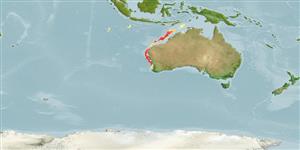Ikan bertulang rawan (sharks and rays) >
Carcharhiniformes (Ground sharks) >
Scyliorhinidae (Cat sharks) > Scyliorhininae
Etymology: Cephaloscyllium: cephalus, from kephale (Gr.), head, referring to its very broad and depressed head; skylion, Greek for dogfish or small shark. (See ETYFish); speccum: From specca (L.), speckled, referring to dark brown spots and blotches that dominate its color pattern. (See ETYFish).
More on authors: Last, Séret & White.
Environment: milieu / climate zone / depth range / distribution range
Ekologi
laut bentopelagis; kisaran kedalaman 150 - 455 m (Ref. 76946). Tropical
Eastern Indian Ocean: Australia.
Length at first maturity / Size / Weight / umur
Maturity: Lm ?, range 64 - ? cm
Max length : 68.0 cm TL jantan/; (Ref. 76946); 69.4 cm TL (female)
deskripsi pendek
Kunci identifiaksi (pengenalan) | Morfologi | Morfometrik
A medium-sized species with the following characters: head 7.8-12.5% TL in height, trunk width 13.0-16.8% TL; origin of first dorsal-fin mostly over posterior of pelvic-fin base; prenarial 3.6-4.9% TL in length; preorbital snout length 1.5-2.0 times prenarial length, 2.6-3.1 in prepectoral length, 5.9-7.1 in prepelvic length; snout-vent length long, 47.4-51.1% TL; nostril 2.2-2.7% TL in width; eye-spiracle space narrow, 0.4-1.0% TL; pectoral fin medium-sized, height 8.9-13.8% TL, posterior margin 8.5-13.3% TL; anal fin tall, 3.2-4.4% TL; anal-caudal space 4.5-6.1% TL; precaudal 76-78% TL in length; interdorsal space 6.5-8.6% TL; teeth have 3-5 cusps; unicuspidate or weakly tricuspidate flank denticles; back with no greatly enlarged denticles; adult clasper long, outer length about 7% TL, well short of anal fin, interspace about 1.9% TL; vertebral centra 111-115; tooth count relatively high, 69-97 teeth in each jaw; color of upper half of body pale, with a strongly variegated pattern that is well-demarcated from the ventral surface; dark saddles (8) evident on body and caudal fin; pale variegated dorsal fins; dark blotch over gills absent; distinct V-shaped marking on posterior margin of terminal lobe of caudal fin absent; upper surfaces of pectoral and pelvic-fin without a dark central blotch; without dark saddle extending onto caudal peduncle above origin of ventral lobe of caudal fin; uniformly pale on the ventral surface; color of juveniles pale, with dark lines and spots forming rosettes and linear saddle markings, and the markings between spiracles separated into two unconnected pseudo-ocelli (Ref. 76946).
Life cycle and mating behavior
Maturities | Reproduksi, perkembang biakan | Spawnings | Egg(s) | Fecundities | Larva
Last, P.R., B. Séret and W.T. White, 2008. New swellsharks (Cephaloscyllium: Scyliorhinidae) from the Indo-Australian region. In Last, P.R., White, W.T. & Pogonoski, J.J. (eds.): Descriptions of New Australian Chondrichthyans. CSIRO Marine and Atmospheric Research Paper no. 22. (Ref. 76946)
Status IUCN Red List (Ref. 130435)
ancaman kepada manusia
Harmless
penggunaan manusia
Alat, peralatan
laporan khas
muat turun XML
Sumber internet
Estimates based on models
Preferred temperature (Ref.
123201): 11.4 - 16.5, mean 13.4 °C (based on 21 cells).
Phylogenetic diversity index (Ref.
82804): PD
50 = 0.5000 [Uniqueness, from 0.5 = low to 2.0 = high].
Bayesian length-weight: a=0.00263 (0.00139 - 0.00497), b=3.21 (3.04 - 3.38), in cm total length, based on LWR estimates for this (Sub)family-body shape (Ref.
93245).
Trophic level (Ref.
69278): 4.1 ±0.5 se; based on size and trophs of closest relatives
Daya lenting (Ref.
120179): Rendah, Waktu penggandaan populasi minimum 4.5 - 14 tahun (Preliminary low fecundity).
Fishing Vulnerability (Ref.
59153): Moderate to high vulnerability (48 of 100).
